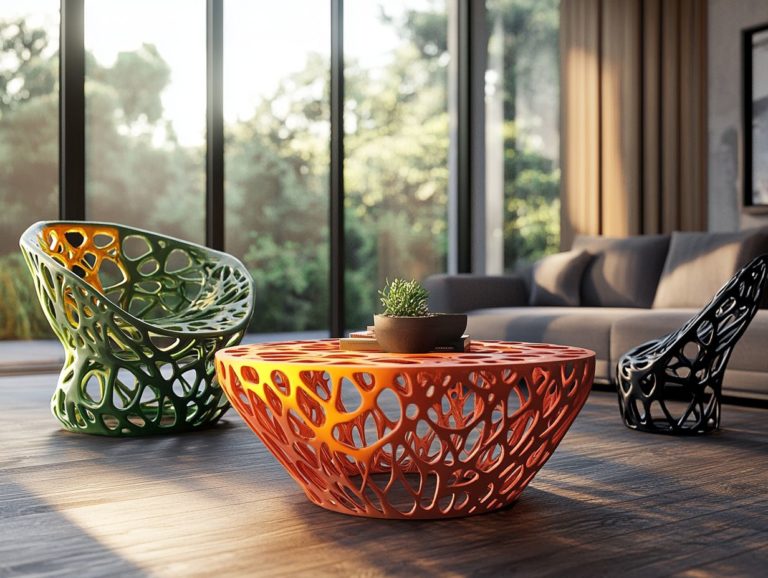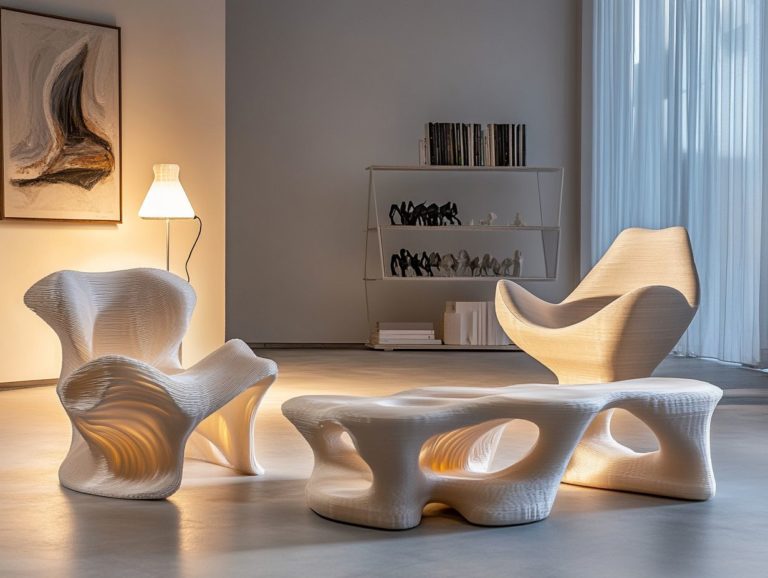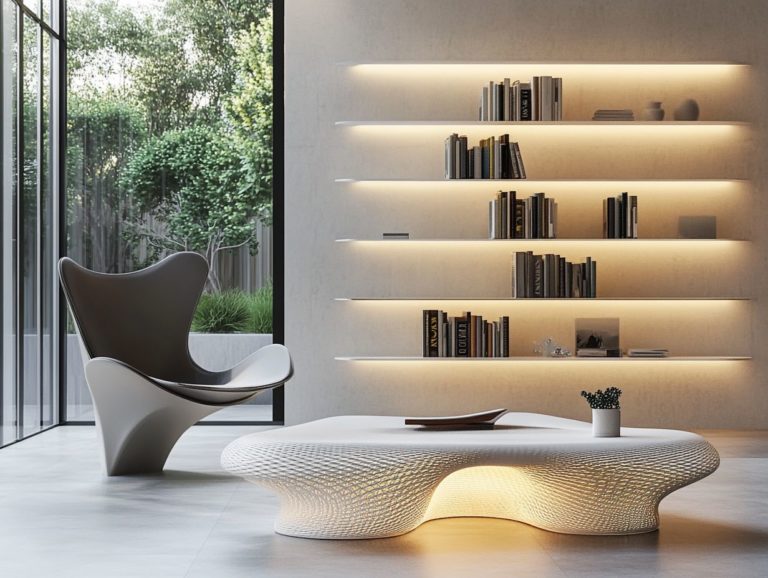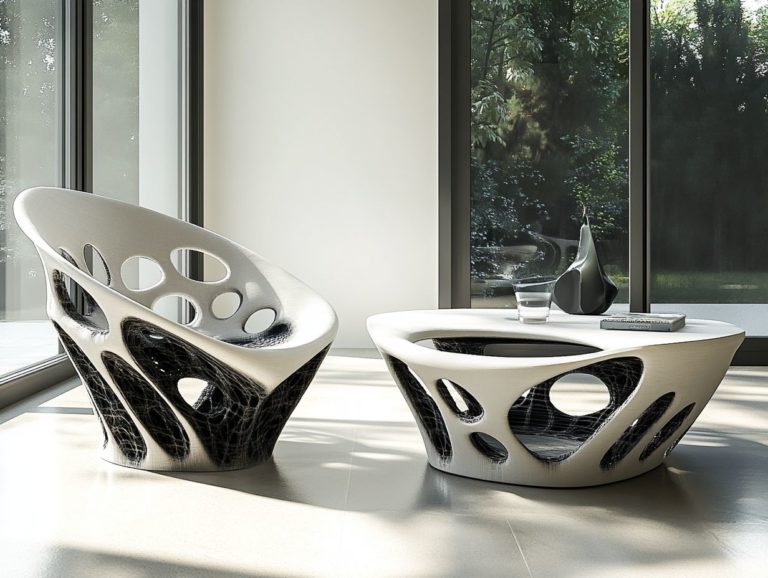5 Reasons to Choose 3D-Printed Furniture
In today s fast-paced world, innovation is completely redefining your approach to design and functionality, particularly in furniture.
3D-printed furniture stands at the vanguard of this revolution, offering unique advantages that traditional methods simply can t compete with. Imagine the stunning customization options, cost-effective production, and eco-friendly materials at your disposal the benefits are both practical and exhilarating.
This article delves into five compelling reasons for you to embrace 3D-printed furniture, complete with insights into its materials, limitations, and future potential.
Dive in and discover how this cutting-edge technology is transforming the way you furnish your spaces!
Contents
Key Takeaways:

- Customize your furniture to fit your unique style and needs.
- Save money on production costs with 3D printing technology.
- Pave the way towards a more environmentally-friendly and sustainable future by choosing 3D-printed furniture.
1. Customization Options
Customization options in the 3D printing realm for the furniture industry offer you unparalleled design freedom. This enables you to create unique pieces that cater specifically to your needs, and you can explore 5 ways to personalize your 3D-printed furniture while tackling sustainability issues tied to consumer waste.
By utilizing adjustable furniture models and bespoke dimensions, you can discover products that seamlessly fit your living spaces, enhancing both functionality and aesthetics. This tailored approach elevates your satisfaction and plays a vital role in reducing material waste, as each piece is crafted to meet your individual requirements instead of relying on generic mass production.
As environmentally conscious individuals increasingly seek sustainable options, these 3D-printed innovations present a compelling alternative. They blend modern technology with an eco-friendly mindset. This not only reshapes product development but also allows you to make more responsible choices in your home furnishings.
2. Cost-Effective Production
The cost-effective production capabilities of 3D printing are transforming manufacturing processes in the furniture industry. This helps you reduce both material waste and inventory management challenges, leading to substantial economic benefits for your business.
By leveraging advanced 3D printing methods, you can realize significant cost savings, especially in labor and materials. Traditional methods often result in excess material that ends up wasted, whereas 3D printing offers precision and customization, minimizing leftover scraps.
Take a cue from industry leaders like IKEA, who have adopted these innovative methods to streamline their production lines and drastically reduce resource consumption for their designs. This boosts efficiency and enables you to create tailored solutions that meet consumer demands all while keeping your operational costs in check.
3. Sustainable and Eco-Friendly
3D printing presents remarkable opportunities for sustainability, allowing you to utilize eco-friendly materials like biocomposites and carbon-neutral options. This aligns perfectly with the rising demand for responsible manufacturing in the furniture industry.
By integrating materials such as PLA (polylactic acid), which comes from renewable resources, you not only minimize your environmental impact but also open doors to innovative designs that can be crafted with remarkable precision. These sustainable choices significantly reduce your carbon footprint by lowering reliance on fossil fuels and curtailing the toxic emissions typically linked to traditional production methods.
Such materials empower you to unleash greater creativity in your designs, enabling you to produce lightweight yet durable furniture that caters to the tastes and values of today s eco-conscious consumers. As the furniture industry progresses, embracing these pioneering materials is essential for securing a sustainable future.
Don t miss out on the chance to explore 3D-printed furniture options available in the market!
4. Faster Production Time

Faster production time is the hallmark of 3D printing, providing you with the ability to engage in rapid prototyping and streamline manufacturing processes, significantly shortening the timeline for developing new furniture parts and models.
This technology gives you the power to quickly iterate on ideas and test concepts in real-world scenarios before committing to full-scale production. Take Medaarch, for example; they ve harnessed the power of 3D printing to craft customized furniture solutions tailored to specific client needs, transforming weeks of traditional manufacturing into mere days.
Batch.Works has demonstrated how they utilize this technology to create components that are both functional and aesthetically pleasing, enabling swift adaptations to market trends. These advancements illustrate the profound implications for your product development. They highlight a shift towards agile manufacturing and enhanced market responsiveness, allowing you to meet consumer demand swiftly and efficiently.
5. Unique Designs and Shapes
3D printing gives you the power to create unique designs and shapes that were once considered unattainable through traditional methods, effectively overcoming design challenges and enabling the construction of innovative structures in the furniture industry.
This revolutionary technology opens up a realm of creative possibilities, allowing you to explore designs that beautifully blend artistry with functionality. Designers like Jurij Rahimkulov exemplify this by crafting multi-dimensional furniture pieces that morph and adapt to various needs, showcasing the remarkable versatility of materials used in 3D printing.
Frank Ligthart’s work demonstrates how this technique can yield sustainable, customizable furniture that caters to diverse aesthetic preferences. These unique models break the mold of traditional design and resonate deeply with modern consumers like you, who seek individuality and sustainability in their living spaces.
How Does 3D Printing Work for Furniture?
In the furniture industry, 3D printing uses specific methods like digital production and Computer-Aided Design (CAD), allowing you to create furniture that meets your design needs and streamlines your overall workflow.
You start by crafting a virtual prototype using sophisticated CAD software, which becomes the blueprint for your project. Once you finalize the design, it s converted into a format that your 3D printer can understand, often involving slicing the model into layers.
The printer then meticulously constructs the item layer by layer, utilizing materials ranging from plastics to metals, ensuring exceptional detail and accuracy. Recent advancements in a technique that allows for larger 3D prints have revolutionized furniture design, facilitating the rapid and efficient manufacturing of larger, more complex structures. This not only reduces waste but also promotes customization that seamlessly aligns with modern aesthetics.
What Materials Can Be Used for 3D-Printed Furniture?
You can explore a diverse range of materials for 3D-printed furniture, such as PLA plastic and biocomposites, each bringing unique advantages in durability, sustainability, and aesthetic charm. For innovative ideas, be sure to discover 5 unique 3D-printed furniture concepts.
Among these, PLA (polylactic acid) shines as a biodegradable choice derived from renewable resources, making it particularly appealing to environmentally conscious designers like you. Its lightweight nature makes for effortless handling, and the variety of colors and finishes available can elevate any interior space.
Biocomposites incorporate natural fibers like hemp or wood dust, offering enhanced strength and a distinctive texture that beautifully mimics traditional materials. These options not only enhance the functionality and longevity of your furniture but also help minimize your ecological footprint, catering to those who prioritize sustainability without sacrificing style or performance.
Imagine creating furniture that perfectly fits your vision in mere days! Explore the world of 3D-printed furniture today and unlock endless design possibilities!
What Are the Limitations of 3D-Printed Furniture?

While 3D-printed furniture offers numerous advantages, it also presents certain limitations that you need to consider. These include design challenges and constraints tied to specific manufacturing processes, which can affect the quality and usability of the final product. To stay informed, explore these trends in 3D-printed furniture that you should know.
You may encounter various issues, such as size restrictions that prevent the creation of larger pieces and compatibility problems with different materials that could diminish performance. Potential structural weaknesses may arise from the layer-by-layer construction, potentially compromising the furniture’s durability.
To successfully navigate these obstacles, adopt innovative strategies. Optimize designs for printability, select composite materials (materials made from two or more constituent materials) that enhance strength, and incorporate reinforcement features to improve structural integrity.
By leveraging advanced software tools and collaborating with material scientists, you can effectively address these challenges. This approach leads to a more functional and visually appealing end product.
How Can 3D-Printed Furniture Benefit Interior Design?
3D-printed furniture offers remarkable advantages in interior design. It presents unique designs and extensive customization options that enable you to craft personalized spaces tailored to your clients’ tastes and needs, including ways 3D-printed furniture can save you money.
This groundbreaking technology gives you the power to breathe life into your creative visions, incorporating elements that traditional manufacturing methods might have deemed impractical or impossible. For example, the illustrious interior designer Zaha Hadid harnessed 3D printing to create stunning, fluid furniture pieces that embody her signature aesthetic, seamlessly merging artistry with functionality.
Many designers are also exploring sustainable materials for 3D printing, resulting in eco-friendly creations that attract the environmentally conscious consumer. As this technology continues to evolve, the potential for bespoke solutions in interior design appears limitless, establishing a new benchmark for personalized living spaces.
What Are the Future Possibilities of 3D-Printed Furniture?
The future possibilities of 3D-printed furniture are nothing short of exciting, especially with unique 3D-printed furniture items on the horizon that promise to elevate sustainability, design diversity, and adaptability in the furniture industry.
As emerging technologies refine production techniques, anticipate designers harnessing a wider array of eco-friendly materials, ranging from biodegradable plastics to recycled composites. This shift caters not just to your growing desire for sustainable options but also enables customized, on-demand manufacturing that significantly reduces waste.
With advancements in printing speed and precision, get ready for furniture that s not only visually stunning but also tailored to your unique needs and preferences. These trends herald a transformative era for the industry, aligning furniture production with contemporary values of sustainability and personalization.
What Are Some Popular Examples of 3D-Printed Furniture?
Several popular examples of 3D-printed furniture showcase the amazing versatility and creativity of this technology, particularly through impressive installations at events like Milan Design Week, where traditional design boundaries are truly pushed.
Take the “FurniCoil” chair, for instance. Designed by a collaborative group of creative minds, it draws inspiration from natural forms and emphasizes ergonomic functionality, making it a practical addition to your contemporary living space.
Then there’s the “Print-a-Chair” project, which employs a digital fabrication process (a method of creating items using digital designs and machines) to streamline production while maintaining an artistic aesthetic.
Both pieces have garnered accolades from industry experts and ignited conversations about sustainable manufacturing practices. Events like the London Design Festival further highlight innovative designs that seamlessly merge aesthetics with functionality, demonstrating how the design world wholeheartedly embraces 3D printing as a pivotal force in revolutionizing furniture creation.
Discover how this technology transforms your living space!
Frequently Asked Questions
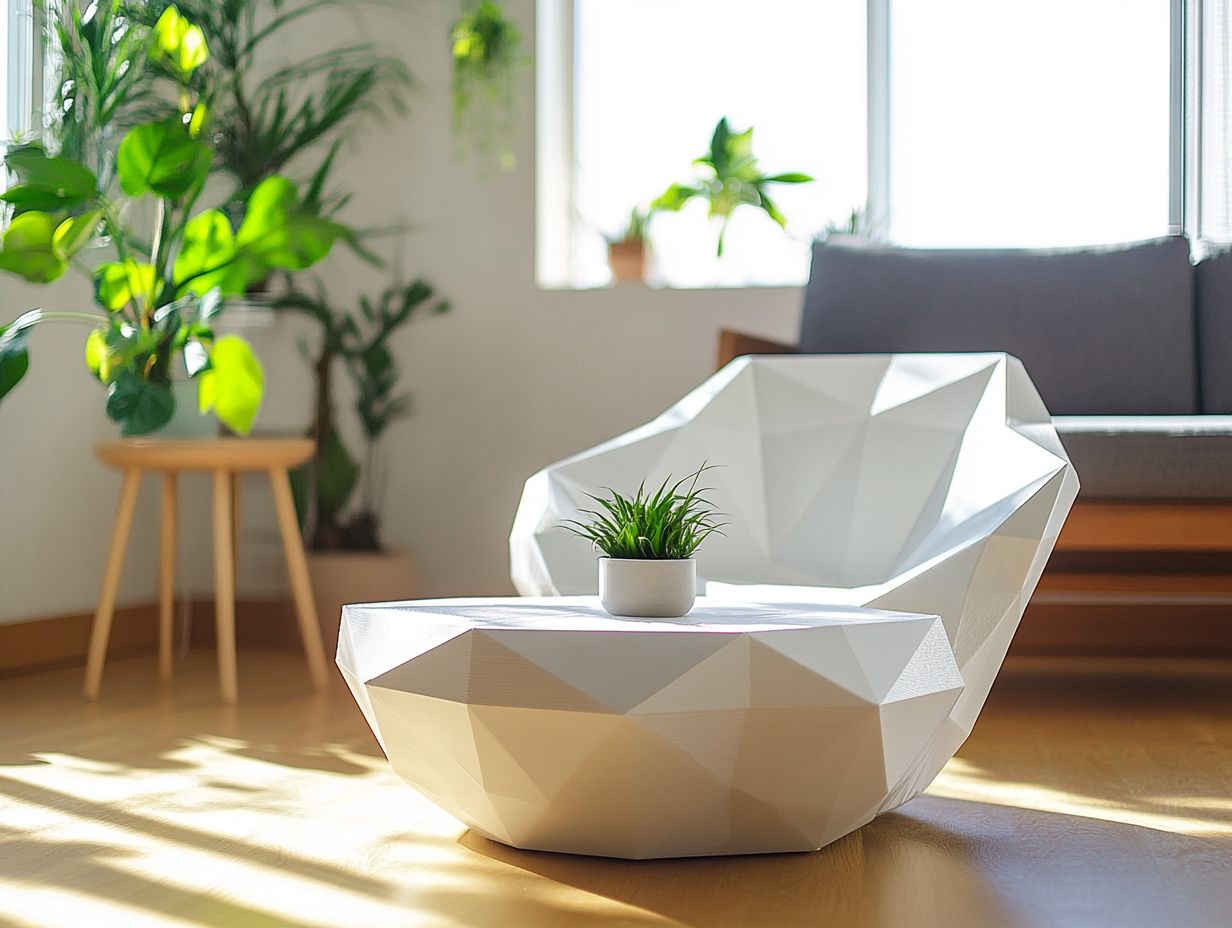
What is 3D-printed furniture?
3D-printed furniture is made using a 3D printer. This printer creates objects layer by layer based on designs made with special software.
What are the benefits of choosing 3D-printed furniture?
This type of furniture offers many advantages. You can enjoy customization, faster production, lower costs, sustainability, and unique designs.
How is 3D-printed furniture customizable?
With 3D printing, you can fully customize your furniture. Choose the size, shape, color, and even intricate details that suit your style by following these 5 tips for designing your own 3D-printed furniture.
Is 3D-printed furniture more affordable?
Yes, it is often cheaper than traditional furniture. The 3D printing process lowers production costs, making it a budget-friendly choice.
What makes 3D-printed furniture more sustainable?
This method produces less waste and saves energy. It also cuts down transportation needs, making it a greener option for furniture production.
Are there any limitations to 3D-printed furniture?
While there are many benefits, 3D-printed furniture does have some limitations, such as size restrictions and the type of materials used. However, advancements in technology are rapidly addressing these challenges, leading to stylish 3D-printed furniture solutions for your home.

